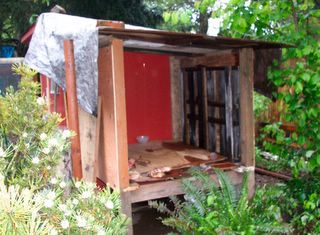Recently a teacher my husband subs for suggested that we might be very happy with a couple of sheep (this was a day or two before the truck engine blew up). While I am very tempted, we have to resolve the issue of a replacement vehichle first so we can continue to enjoy the flock we already have. As a fiber arts enthusiast (oh please don't confuse that with skill or anything!) I would love to have sheep!
However, if you are in the Eugene area and would like some Shetland cross sheep we can connect you with the owner. These sheep are not for eating! The are small sized sheep, so not the best choice for meat--but their high quality fleece will make you very happy if you like to spin, felt, weave, knit...additionally, we have been told the adults are quite friendly.
Lambs are $40, sheep are free--but all must be going to good homes, and my guess would be going in pairs at a minimum as they are flock animals and will be unhappy in isolation. If you live in the Eugene city limits and have a lot of 20K feet or larger, it is legal for you to have sheep--and chickens of course! Still a little unsure, check out this site for inspiration!
Saturday, May 28, 2005
Traffic Jam in the Coop!

Nesting box pile up! This is what happens when a bunch of hens decide they all want to lay right now! There were nesting boxes not in use, but even so the always resourceful auracanas decided to buck standard convention and lay in a rustic, home made nest, visible to the left of the wooden pespi crate nesting box!

I Was Here First!
Sunday, May 22, 2005
Hens Gorge on Garden Greens
The Hen Snack Bar

Here is a pic of the partially moved "worm bin". If you scroll down to the "Hen Hilton" post, you might be able to make out a pile of logs with what appears to be straw inside...in the Fall we raked up all the maple leaves and mulched our garden--but we had such an excess that we ended up with a pile on the cement pad in front of the coop over the winter and spring. When we would let the hens out they would run to this pile and peck around, so we began to assume their must be snackables in the composting mass of straw and leaves. And wow, were we suprised! We found tons of worms, including a bunch that were as thick as my pinky and several inches long! We decided to try to clear off the pad and move the worm pile into the run--although I don't know how long it will remain stocked with worms. You can see the pile here, encircled by logs, and butted up against the fence. On the other side are cinder blocks which our neighbor uses to enclose his worm bin/compost pile.

How to Discourage Broodiness
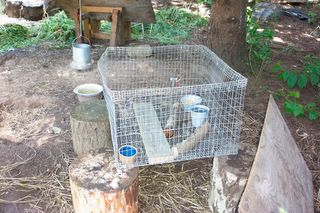
You might be wondering exactly why we have a cage in the chicken run when we refer to our hens as truly free range. This is our "Broodiness Discouragement Cage".
A hen goes "broody" when they decide to lay on a clutch of eggs, as if to hatch them. The hen will fluff up her feathers to elevate her body temperature, and pluck her breast bare to keep the eggs warm and humid. With modern breeds this natural motherhood drive has in many cases been bred out of the hens, and sometimes if hens go broody they don't always sit until the chicks pip out. Certain breeds and types of chickens (such as bantams) are noted for their fine mothering skills, but not all hens possess this anymore.
In our situation especially, without a rooster, our chickens will never hatch out a clutch of eggs. But still, they get broody. Increasing amounts of daylight can bring this on, and perhaps some breeds are more sensitive to this tendency than others. About a month ago, two of our hens, Puja, a black Australorp, and Goldie, a Buff Orpington went broody--and stayed broody!
When a hen goes broody, they rarely leave their nest, although ideally they leave the nest once a day to eat, drink water, and poop (usually the largest chicken poop you have ever seen in your life, but that might be more detail than some would like). So for chickens without a rooster, or with a mothering instict that has been bred away or into a flawed form of what nature intended, it can actually be a big deal if they go broody and stay that way. We heard from both the extension service and several feed stores that hens can starve to death or dehydrate.
We also heard numerous methods to discourage broodiness, including dunking the chicken in water, or submerging their head. Now, I don't know what people are thinking, because chickens can catch cold and die if they get wet and then chilled, and I refuse to believe that submerging anyone's head in water against their will would be useful. We had also heard that putting broody hens in a cage that was suspended from a branch or beam so it could swing would dispell broodiness. That sounded about as fun as vomiting on a ride at the county fair.
Let me be the first to tell you that hens can be treated humanely, it's a great thing to lead with. We decided after researching it and asking for more information on the broody cycle that the most important thing was that the hen's body temperature had to be reduced in order to disrupt the hormonal cycle that was telling these hens to sit on the nest until they had chicks pipping out. So we took our two broody hens, and put them in a 3.5' X 3.5' cage, which we hoisted on 4 stumps. They had ample food and water, and we weighted a piece of plywood over the top so they couldn't get out.
The wire bottom cage prevented the hens from keeping their body temperature elevated. At night we put the hens in the coop of course, and after two days the broody cycle was disrupted! We expect the formerly broody hens will go into a molt nearly immediately, and maybe resume laying eggs in a month or more.
Today Puja and Goldie were out with the rest of the chickens--although periodically Puja or Goldie would wander back into the coop and check out the nests. Michael or I would quickly open the coop door, and say to formerly broody hens, "Oh no you don't! Don't you even look at that nest! Get back out side or we're putting you back in the cage!"

Roosting
Where's the Snacks?

Here is a pic of the "Big Girls" rushing me in anticipation of snacks. The quickest way to a chicken's heart is through the stomach. While it's sometimes annoying to have 10 or 15 rush me whenever I go in the run, it's also a very reliable trick for "herding" them. We are continuing to get about 1 dozen eggs a day, although with the additional 4000 square feet of forage area, I think some of the hens are confusing about where to lay their eggs!

Wednesday, May 18, 2005
Rooster on the Horizon?
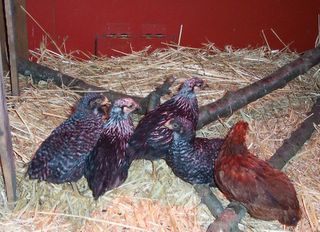
Possible rooster alert! We have our eye on that one, a possible fella in the bunch. Just to the left of our lovely red/brown Mary Ann, we think that chook, known as Rocky, could be a rooster. We are keeping an eye on him. It can take several weeks to be absolutely certain.
There are good reasons to have a rooster, but also some good reasons not to. It's illegal to have roosters in the city limits, even in an on and off again incorporated patchwork zone like ours. While the rooster can do a fine job protecting the flock from danger, they also eat an incredible amount of feed--and in our situation where we aren't so interested in hatching out our own chicks, the whole breeding thing is not a high priority. Additionally, besides being noisey, roosters can become aggressive. Friends of ours who have a rooster in their small back yard flock have reported their over 1 year old rooster has become aggressive toward men! Likewise, roosters always have to be watched around young children--they can do serious harm with their spurs, especially to eyes.

Inside the Luxury Chick Nursery
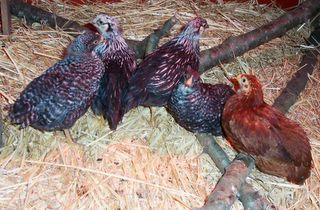
Here are the chicks bedding down after we chased them for 15 or 20 minutes--in the mud and rain mind you. They're just like kids that don't want to go to bed, except they run much, much faster.
This is another view of our friend just to the left of Mary Ann the New Hampshire (red/brown chick)--we've noticed an unnusually large comb on this one, and overall size is larger than the other chicks...

All Hail the Chicken Fencing Guru!
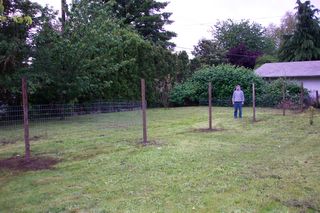
Michael is nothing short of amazing--he put this chicken fence across our neighbor's back yard in 2 hours--and there's a portion that I couldn't fit into the photo. Our neighbor has agreed to let us pasture our chickens in her back lot in exchange for free eggs. This will add another 4000 square feet of fenced in forage access for the hens. Michael only has to put the gate in and secure some "leaks" in the fencing to make it all secure.
Originally when I posted this I listed the square footage as 2500 square feet--Michael measured it and found I was way off! The hens are very, very happy with the extension of forage area. We've been joking about continuing on down the street, just fencing the back of everyone's back yard--"You're not using this area, are you?" Our neighbor suggested we could then get a goat!

More Gorgeous Eggs
Monday, May 16, 2005
The Night Time Dilemma
Q: How many people does it take to put 6 chicks in their coop at night?
A: 3--one to flush them out, one to herd them, and one to grab them and put them in the coop.
It's not a laughing matter! While the chicks have figured out they can go up and down the ramp of their coop, they have not figured out specifically what to do when darkness falls. Tonight they sat out in the dusk cheeping their loud "Help me! Help me!" cheep. I think we need to invest in a butterfly net or something similar.
Barring that, this is my big piece of advice to pass on to others who may someday have a backyard flock: in the beginning days when you have your chicks, hold them, hold them, hold them, teach them to eat from your hand within the first weeks. Take the time early on because you'll end up with hens that are considerably tamer.
The only difference between this younger group and the hens we have that are all 1 year old, is that I wasn't working full time when we got our first group--so I would bring our daughter home (most days) right after her half day of kindergarten, and she did all the devoted work of taming those chooks. When we would enter their run, they would run to us and jump up on our shoulder if we knelt down, they loved being held, and knew to expect food and snackables from us.
This time around I am working full time and so my daughter had considerably less time available to work her magic with the chickies, and we are seeing a telltale difference. These chicks don't know yet that we are actually the source of all things warm and wonderful, like food, access to the heat lamp, cuddling...
For your reading enjoyment, I've included this link to an article from our local paper about chickens in the urban environment. Please feel free to scout around at the site afterward too, some great chicken cam links!
A: 3--one to flush them out, one to herd them, and one to grab them and put them in the coop.
It's not a laughing matter! While the chicks have figured out they can go up and down the ramp of their coop, they have not figured out specifically what to do when darkness falls. Tonight they sat out in the dusk cheeping their loud "Help me! Help me!" cheep. I think we need to invest in a butterfly net or something similar.
Barring that, this is my big piece of advice to pass on to others who may someday have a backyard flock: in the beginning days when you have your chicks, hold them, hold them, hold them, teach them to eat from your hand within the first weeks. Take the time early on because you'll end up with hens that are considerably tamer.
The only difference between this younger group and the hens we have that are all 1 year old, is that I wasn't working full time when we got our first group--so I would bring our daughter home (most days) right after her half day of kindergarten, and she did all the devoted work of taming those chooks. When we would enter their run, they would run to us and jump up on our shoulder if we knelt down, they loved being held, and knew to expect food and snackables from us.
This time around I am working full time and so my daughter had considerably less time available to work her magic with the chickies, and we are seeing a telltale difference. These chicks don't know yet that we are actually the source of all things warm and wonderful, like food, access to the heat lamp, cuddling...
For your reading enjoyment, I've included this link to an article from our local paper about chickens in the urban environment. Please feel free to scout around at the site afterward too, some great chicken cam links!
Saturday, May 14, 2005
Another Great Site for Chicken Research
What a busy day we had--up early to frantically finish the coop, and the chicks enjoyed their first day out in their mini run...only problem was at sunset the little chooks didn't know what to do, that they had to go in their coop or become racoon appetizers!
That's the whole problem with domestication and industrialized poultry as I see it--the chicks have no mamas to teach them these things, and when they are hens they can't be trusted to rear young. Seems a little self-defeating if you ask me, but I have hopes that some of the breeds are untampered with enough that they can still rise to the occaision. I've heard that bantams make stellar mothers.
Today Maia had a play date with a friend who's family will be getting chickens soon. They live a little more rurally than we do, but all the same I think the City Chicken web site is a great starting point for any family who didn't grow up with poultry wanting to give it a go.
Another fantastic site that has lots of great information about rearing chicks, coop design, etc. is Feathersite. This site is hands down the best on the web for researching chicken breeds. I particularly like that each breed page shows pictures of the young and adults, making it easy to distinguish when you have a mixed breed lot of chicks!
I'll be posting more sites in coming weeks, for now I'm going to grab my flash light, make sure the chicks are at the right temperature since it's cooled off outside, and then fold some laundry.
That's the whole problem with domestication and industrialized poultry as I see it--the chicks have no mamas to teach them these things, and when they are hens they can't be trusted to rear young. Seems a little self-defeating if you ask me, but I have hopes that some of the breeds are untampered with enough that they can still rise to the occaision. I've heard that bantams make stellar mothers.
Today Maia had a play date with a friend who's family will be getting chickens soon. They live a little more rurally than we do, but all the same I think the City Chicken web site is a great starting point for any family who didn't grow up with poultry wanting to give it a go.
Another fantastic site that has lots of great information about rearing chicks, coop design, etc. is Feathersite. This site is hands down the best on the web for researching chicken breeds. I particularly like that each breed page shows pictures of the young and adults, making it easy to distinguish when you have a mixed breed lot of chicks!
I'll be posting more sites in coming weeks, for now I'm going to grab my flash light, make sure the chicks are at the right temperature since it's cooled off outside, and then fold some laundry.
The Chicks Move in to The New Addition

And the big day is finally here--the weather is cooperative (so far), and Michael finished the lovely Dutch door. Together we quickly set up the fencing, and then after Michael left to do his landscaping accounts, I adapted the fencing to include a somewhat workable entrance point, and then made the ramp. At the base of the ramp you can see Mary, the New Hampshire. Hopefully they remember how to go up the ramp when it rains!

The Roof is Complete

Here is the very nearly finished coop addition--you can see the outline of one of the pallets we used to frame it in. The doors weren't quite done yet--once Michael put them on I reminded him I was interested in Dutch doors, the kind where the top can open independently from the bottom. That might sound like a nit-picky wife request, but at this stage the interior of the coop will still be artificially heated, so a smaller door opening will be necessary to preserve some heat.

Thursday, May 12, 2005
You Can Do This Too!
This is the web site that helped me believe I could have chickens in my backyard. This woman lives in SE Portland, and check out how small her yard it. In Eugene 4 hens (no roosters!) is the legal limit for lots under 20,000 square feet.
Coop Addition Nearly Finished!
Yesterday Michael finished tar papering the roof, put on the shingles, and added the front doors for the coop. We still have to add flashing to the roof and also turn one of the coop addition doors into a dutch door. Hopefully by this weekend the chicks will be out of the house, with their own fenced mini-run.
At this stage, just over 4 weeks of age, the cats shouldn't be able to snag a chick through the chicken wire fencing...
The big girls are still producing about 1 dozen eggs a day--so we have plenty of eggs to sell, still $2 per dozen.
At this stage, just over 4 weeks of age, the cats shouldn't be able to snag a chick through the chicken wire fencing...
The big girls are still producing about 1 dozen eggs a day--so we have plenty of eggs to sell, still $2 per dozen.
Tuesday, May 10, 2005
Chickens are Not Vegetarians
I decided it would be better to avoid photos for this--don't believe all the hype about chickens on "vegetarian diets". While I do think it's best to avoid feeding ground up rotten and/or diseased cows, chickens or other livestock to hens, chickens are absolutely not vegetarian creatures. Bugs & worms aside, they are total protein fiends and will take great pains to get as much protein as possible.
We have heard from other flock owners that they have noticed their hens will chase down mice and gorge themselves if given the chance. We observed last summer that our hens had caught a snake, and then chased each other around trying to snatch morsels to dine on.
Two days ago I saw something a little odd out in the run, and then I realized it was remnants of a snake carcass, so our "vegetarian" flock was at it again, and apparantly had a lovely snack.
For other small flock owners out there, I heartily recommend feeding organic liver to your chickens. In the late winter/early spring our flock was beginning to look a little ragged, and we fed them a deer liver and hunter had given us. The liver had spent many weeks in the freezer, so all bugs and parasites were long dead, and we simply thawed the liver and fed it to them raw.
Within 24 hours the protein and vitamin A infusion made such an obvious difference in appearance of the flock that I'll be accepting donations of deer and elk liver again this fall!
We have heard from other flock owners that they have noticed their hens will chase down mice and gorge themselves if given the chance. We observed last summer that our hens had caught a snake, and then chased each other around trying to snatch morsels to dine on.
Two days ago I saw something a little odd out in the run, and then I realized it was remnants of a snake carcass, so our "vegetarian" flock was at it again, and apparantly had a lovely snack.
For other small flock owners out there, I heartily recommend feeding organic liver to your chickens. In the late winter/early spring our flock was beginning to look a little ragged, and we fed them a deer liver and hunter had given us. The liver had spent many weeks in the freezer, so all bugs and parasites were long dead, and we simply thawed the liver and fed it to them raw.
Within 24 hours the protein and vitamin A infusion made such an obvious difference in appearance of the flock that I'll be accepting donations of deer and elk liver again this fall!
Monday, May 09, 2005
Chickens at Rest

Ok, maybe it's mean, but I couldn't resist taking a pic of the hens at night when they were asleep. I woke a few of them when I opened the coop door to take this, and then submitted them to my flash--in reality the coop was pitch black! You can see from the photo that the chickens sleep on roosts. We've used a criss-cross branch pattern made of salvaged limbs from tree prunings here on the properpty.

Time to Build an Addition!
Side View of the Addition

This is the side view of the new addition. Initially this will house only the new chicks, but eventually we will use a sawzall to cut out the wall separating the two and integrate this into use for the whole flock. It is off the ground, so that eventually we can install a wire-bottom floor, allowing droppings to fall out for easier cleanup. Note the ready-to-use shovel hanging from the main coop!

Take a Peek Inside
Sunday, May 08, 2005
Meet the Head Coop Designer
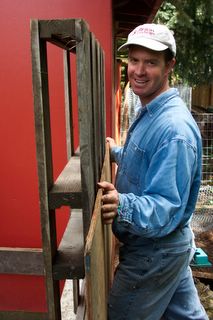
This is my hunky husband attaching an outer plywood wall to the frame we made using pallets. I have sometimes criticized his stockpiling of salvage wood that he brings home, but today I was eating crow--we still have tons of wood left over after this project, and have only spent about $7 for nails & screws for this addition!
Michael has built all dwelling space for the hens, and done all the fencing himself, including fencing to protect our neighbor's garden. I feel extremely fortunate that he likes doing this kind of thing--I don't mind helping when I have time, but I can always think of other things to do first!

Phase One of the Addition

This is a shot of the initial framing in for the addition to the coop. All materials for the project are salvaged (free, free, free!), even the 2" x 4"s, 2" x 6"s, and the 4" x 4"s. We are trying a new design for this, based upon a cool coop design our friends Tanja & Zorba have for their back yard flock.

The Hen Hilton

This is the view of the original coop, an 8' X 4' X 6' wood frame construction Hen Hilton on cement slab. The coop has an entrance directly into the run, as well as 2 windows and eave ventilation. This coop was made of recycled materials, including windows & doors, as well as hinges. Even the fence posts for the run have been recycled, and at least 1/3 of the wire for the fencing is also recylced.
Just behind Lauren Beak-all is one of our "worm bins"--we have filled this with chicken manure infested straw (from coop clean up), leaves, and other compostables. Now it is filled with worms and other delectable bugs. The chickens will get in and scratch around for a little snack. Soon we will be harvesting the compost for our garden.
Our permaculture-enthusiast neighbor was initially very worried about using any of the chicken manure straw for his compost, primarily because chicken manure is viewed as being very "hot". Today he commented that he thinks his worms love the chicken manure, he's never seen them in such quantities and attributes it to the chicken poop spiked compost he's been experimenting with.

Sweet, our Favorite Chick
Chooks at Play

This is a close up of the 4 week old chicks inside the brooder, running too and fro. We had to tape a large rubber ball to the top of the waterer because they kept climbing on top of it and tipping it over. The chicks live with sawdust shavings for their litter at this age--but only pine because the oil in the cedar shavings can kill them.

Kids love Chooks!
Example of Indoor Brooder

This is a shot of the brooder inside the house. We start out with a 50 gallon plastic tub, and by 2-3 weeks they outgrow this--the real problem is they can jump out too easily! This wood crate was something Michael picked up someplace, the walls are high enough that the now 4 week old chooks have to work to fly up.
There are advantages and disadvantages to having the chicks in the house with us. The primary disadvantage would be the constant cheeping and peeping, as well as the very fine dust they create from all their scratching. The advantages are ease of climate control, easier to care for them on a daily basis. Additionally, the more time they spend with us at this stage, the friendlier they will be as laying hens.

Saturday, May 07, 2005
The Next Generation

In mid-April we got 6 day old chicks, one New Hampshire (a Rhode Island Red spin off), 3 barred rocks, and 2 silver laced wyandottes. We'll be posting more photos as time goes on. This photo is from the chicks first day at home with us.
When they are young the chicks do not have enough feathering to keep warm, and so we provide an indoor "brooder" with a heat lamp. Each week we raise the heat lamp a little farther from the brooder--they start out needing heat of about 90F, and we decrease it by 5F per week. Hopefully they are feathered enough right about the time it gets warm enough to put them outside.

Subscribe to:
Posts (Atom)





